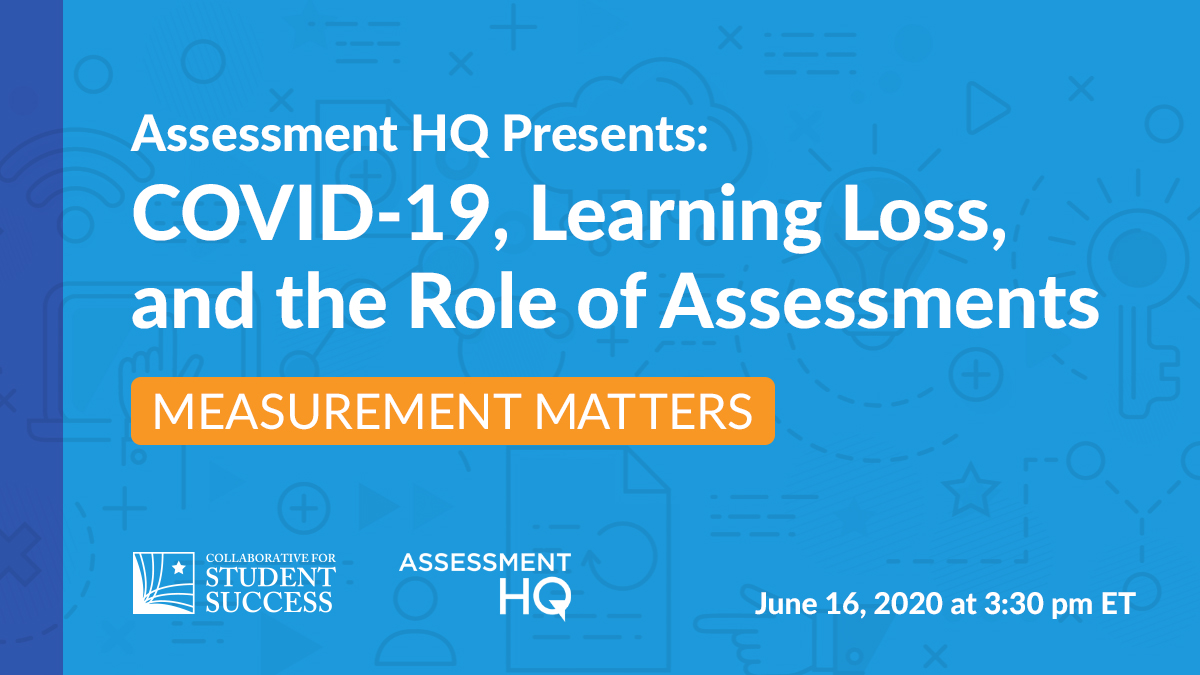RECAP: Assessment HQ Presents Measurement Matters – June 16, 2020

The role of assessments when schools reopen was the key topic on June 16 as Dale Chu, author of Assessment HQ’s Testing 1-2-3 blog, led a thoughtful dialogue on why Measurement Matters with Bill Porter, Partner at Education First, and Chris Woolard, Senior Executive Director for Performance and Impact at the Ohio Department of Education.
The discussion was the first of three online events organized by Assessment HQ, a project of the Collaborative for Student Success, to explore the issue of measuring learning loss amid school closures tied to the COVID-19 pandemic.
As a first step in thinking about measuring learning loss, the panelists affirmed the value that a quality diagnostic assessment can help play in informing “precise and targeted” actions by schools. Such diagnostic tools can be used by teachers and districts to gain rapid access to student performance data to help them develop targeted interventions and focused supports where students need them most.
Specifically, Woolard called attention to a “gap analysis tool” that Ohio is developing so that schools can identify which content standards were covered prior to school closures and which standards must be prioritized to ensure continuity to higher grade levels. Through that analysis, Woolard says, schools ought to answer the question “Where are we at compared to where we would normally be?”
At the state level, he said leaders want to provide helpful resources and support.
“What we don’t want to do is end up in a situation where this question about assessment feels like that it’s not helping or that it’s a burden,” Woolard said. “It has to be framed in how can this help to get schools where they need to be?”
Porter, in turn, emphasized the need for schools to “think creatively” about how to re-engage with students and their families by meeting various needs and communicating clearly about how quality diagnostic data can help schools as they seek to address academic, instructional, and even social and emotional learning needs.
Assessments can be used to provide “targeted augmentation” so that students can move up to the next grade even with having missed exposure to some content, Porter said.
“It’s really important to treat fifth graders like fifth graders and not treat fifth graders like fourth-graders and our assessments should give us the data to kind of strategically go in and tell teachers how to do that,” Porter said.
Overall, the panelists agreed that there is no “right” or single way that state educational agencies should respond to unprecedented educational disruptions. They agreed that all states should focus on ensuring schools and districts have the support and capacity they need to address student needs.
Chu said the reality is that assessments have “understandably” thus far not been in the forefront of states’ and districts’ planning as they look to reopen schools as they juggle many logistical and academic challenges. The panelists said that could shift as parents think more deeply about where their child stands academically with the start of a new school year.
To stay engaged with this ongoing discussion, be sure to attend the two upcoming Assessment HQ online events, Diagnostic Dilemma and Summative Spring, on June 23 and June 30, respectively. Additionally, be sure to stay connected with ongoing commentary from Chu on the Testing 1-2-3 blog on Assessment HQ
About the Collaborative for Student Success
At our core, we believe leaders at all levels have a role to play in ensuring success for K-12 students. From ensuring schools and teachers are equipped with the best materials to spotlighting the innovative and bold ways federal recovery dollars are being used to drive needed changes, the Collaborative for Student Success aims to inform and amplify policies making a difference for students and families.
To recover from the most disruptive event in the history of American public schools, states and districts are leveraging unprecedented resources to make sure classrooms are safe for learning, providing students and teachers with the high-quality instructional materials they deserve, and are rethinking how best to measure learning so supports are targeted where they’re needed most.

